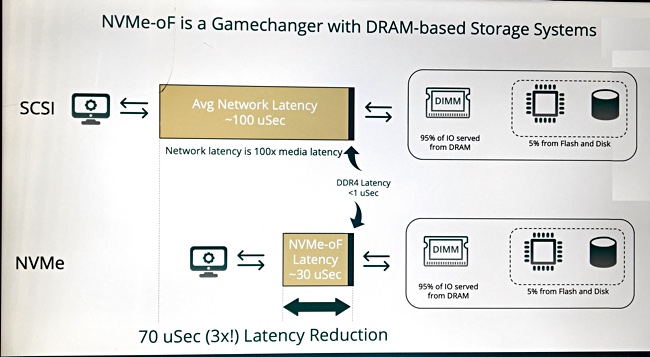Infinidat has added NVMe-oF support to its storage array operating system, in a move intended to preserve its speed advantage over all-flash rivals.
Today’s software update marks the first time a mainstream storage array vendor has offered NVMe access to disk drive-stored data, albeit with a memory cache sitting in front of the disks. Infinidat thinks NVMe will be the pervasive storage access protocol in multi-petabyte enterprises by 2025.
Infinibox 5.6, the latest array operating system release, adds NVMe-over-Fabrics (NVMe-oF) support and extended replication. Brian Carmody, Infinidat CTO, told Blocks & Files: “NVMe-oF with RAM-based IO is like pouring rocket fuel on a fire.”
Infinidat arrays store bulk data on nearline disk drives and rely on memory caching to speed data access times faster than all-flash arrays can serve their data from SSDs.
The new software will be generally available by July 31 and all Infinidat gen 3 arrays are ready for NVMe-oF. They require a non-disruptive software upgrade.
Infinidat today announced the joint 5.5 and 5.6 release of InfiniBox software. 5.5 adds three-way replication to enable a disaster recovery (DR) arrangement. This is not limited by latency or distance, which means InfiniBox DR extends from metro to geographic distances.
The company has added NVMe-oF across TCP/IP – but not Fibre Channel (FC) – with Infinibox 5.6. It says customers are already pleased with the performance of Fibre Channel access InfiniBox arrays, hence its decision to implement NVMe-oF across TCP first.
The NVMe/TCP facility cuts Ethernet link transfer time from about 100 microseconds to around 30 microseconds.

NVMe-oF using RoCE is faster than NVMe/TCP. A year ago, Infinidat showed the round trip latency to an Infinibox array using iSCSI was 172μs for reads and 188μs for writes. This reduced to 32μs for reads and 38μs for writes when using NVMe-oF RoCE.
Infinidat will extend NVMe-oF support for Fibre Channel and RoCE, when customer demand dictates. There are no committed dates yet. Blocks & Files speculates that NVMe/FC will appear before RoCE as this will enable Infinidat to offer NVMe-oF to 95 per cent of the installed base.
Many data centres are choosing to focus on Ethernet rather than Fibre Channel, according to Infinidat. NVMe/TCP adds faster access, at RDMA speeds, to existing iSCSI block access across general Ethernet. NVMe-oF using RoCE (RDMA over Converged Ethernet) requires more expensive data centre-class lossless Ethernet.
Price changes
Infinidat has introduced a new price structure, which includes no-charge migration, 100 per cent availability down to single array level and elastic pricing for burst capacity.
Infinidat has made deployment easier by offering free data migration from existing arrays for new customers. It claims customers migrating from all-flash arrays can double their capacity at minimum without increasing their budget. They should also get a data access speed increase when migrating from all-flash arrays, as memory caching is faster than the SSD access speeds of all-flash arrays.
The company has extended its 100 per cent data availability guarantee to cover single InfiniBox arrays from the minimum of two arrays necessary up until now. The guarantee covers any downtime caused by Infinidat.
An Infinidat customer, Igal Janni, CIO of IFOM (FIRC Institute of Molecular Oncology) in Italy, provides a quote: “Infinidat guaranteed us data availability and they have delivered – we’ve been running InfiniBox for two years and haven’t experienced a single second of downtime.”
The Elastic Pricing scheme lets customers buy a base capacity amount of storage and rent burst capacity when required. Burst capacity can be converted to base capacity without additional fees or penalties. Elastic Pricing updates Infinidat’s existing capacity-on-demand deal.








